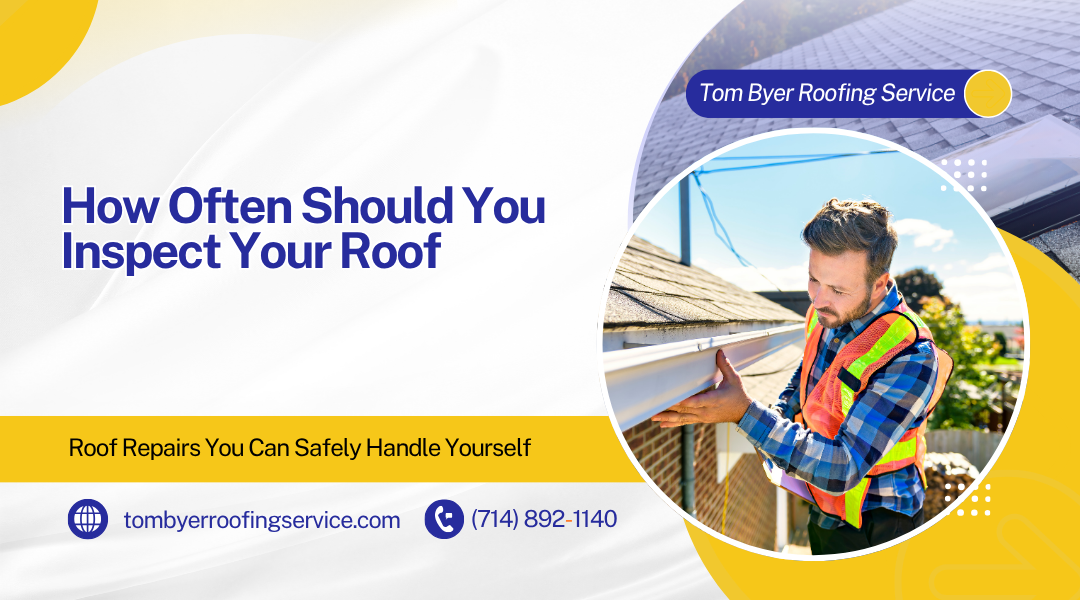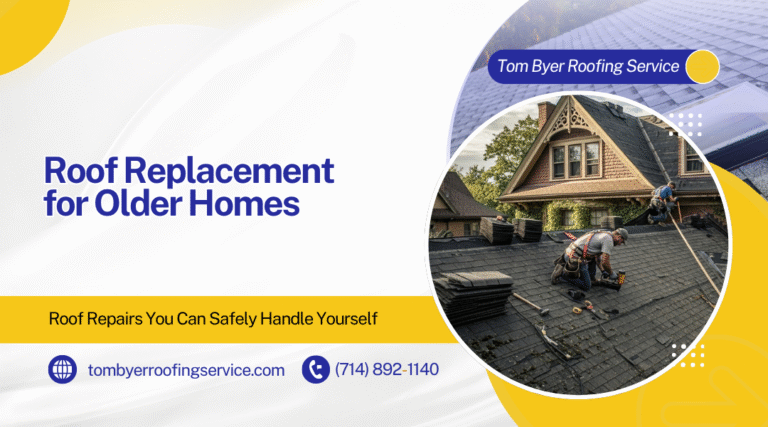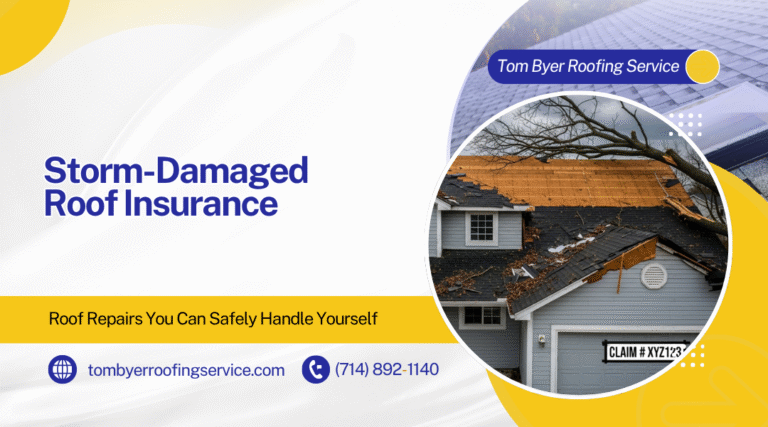Regular roof inspections are essential for homeowners in Garden Grove to maintain the health and safety of their property. Most roofing experts recommend inspecting your roof at least twice a year—once in the spring and once in the fall—to catch damage early and prevent costly repairs. Additionally, inspections after severe weather events are crucial to assess any immediate issues.
Tom Byer Roofing Service, a trusted roofing contractor in Garden Grove, advises that routine roof checks help extend the lifespan of roofing materials and protect against leaks and structural damage. By scheduling timely inspections, homeowners can address minor problems before they escalate, ensuring their roofs remain durable against California’s weather conditions.
Understanding the right inspection frequency empowers property owners to be proactive. This article will discuss why biannual inspections are recommended and how professional assessments from experienced contractors like Tom Byer Roofing Service can safeguard your investment over time.
Why Regular Roof Inspections Are Essential
Regular roof inspections help catch minor issues before they become costly problems. They also contribute to the roof’s longevity and maintain the safety of the home’s structure. These benefits directly impact the homeowner’s expenses and peace of mind.
Preventing Expensive Repairs And Leaks
Roof inspections identify damaged or missing shingles, worn flashing, and early signs of water infiltration. Detecting these problems early can prevent leaks that cause interior damage and mold growth.
Homeowners avoid higher repair costs by addressing small issues on time. Insurance companies often require inspection records for claims, so regular checks support better coverage and claim approval.
Extending The Life Of Your Roof
Routine inspections help maintain the roof’s condition, especially for roofs over 10 years old. Identifying wear and tear or moss growth early slows deterioration.
Proper maintenance based on inspection findings extends the roof’s useful life. This delays the need for a complete replacement, saving homeowners significant expenses over time.
Ensuring Safety And Structural Integrity
Roof inspections help ensure the structure beneath the roof remains sound. They check for loose materials, rot, or damage that could weaken support beams and decking.
By addressing these issues, inspections protect the home against potential collapses or hazardous conditions. This is crucial for maintaining a safe living environment, particularly after storms or severe weather.
Recommended Inspection Frequency
A roof’s condition can change due to age, weather, and usage, so inspections should occur regularly but vary based on specific needs. Frequency depends on roof type, structure, and environmental factors including local climate and surrounding trees.
General Guideline For Residential Roofs
Residential roofs in Garden Grove should be inspected at least once per year. Annual inspections help identify early signs of damage such as loose shingles, cracked flashing, or clogged gutters.
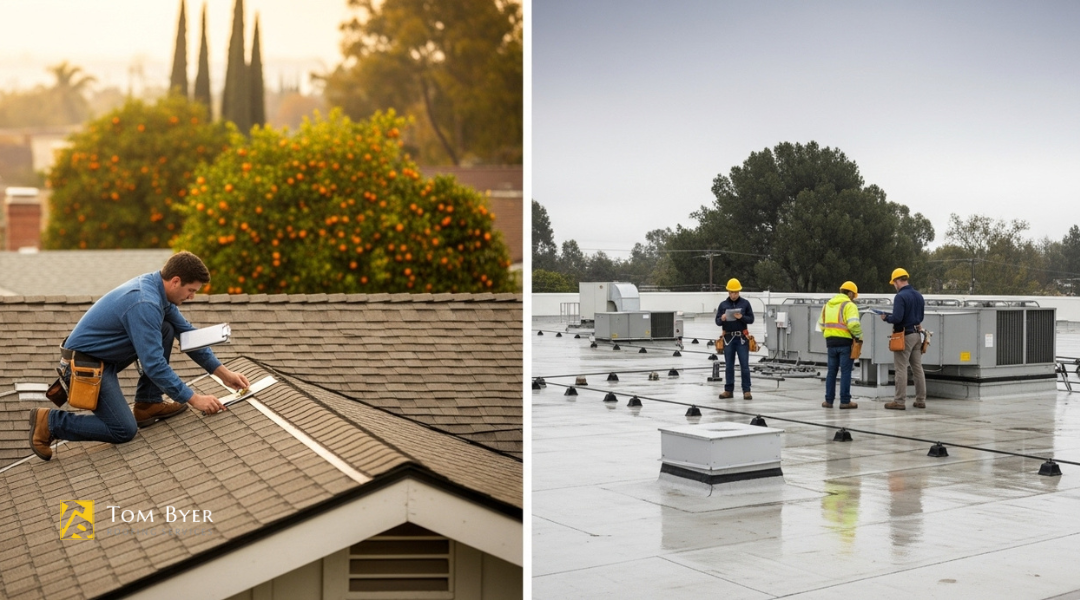
Spring or fall are ideal inspection times. These seasons follow winter storms and precede harsher summer conditions.
Homeowners should also check after major weather events like heavy rain or wind. More frequent checks might be needed for older roofs, generally those over 15 years old, as materials may be more prone to deterioration.
Guidelines For Commercial Roofs
Commercial roofs require inspections more often due to their size, complexity, and heavier equipment usage onsite.
Quarterly inspections are recommended for buildings with flat or low-slope roofs, common in commercial properties. These roofs collect debris and water more easily, which can speed deterioration.
Inspectors must focus on membrane integrity, drainage systems, and structural supports to avoid leaks and costly repairs.
Business owners should also schedule inspections before and after storm seasons to prevent damage that disrupts operations.
Situational Inspections
Certain situations demand inspections outside regular schedules. After severe weather such as hail, high winds, or wildfires, roofs should be inspected promptly for damage.
If a homeowner notices signs like water stains inside their home, missing shingles, or increased energy bills, they should arrange an inspection immediately.
For properties surrounded by large trees, roofs may require more frequent inspections due to risks from falling branches and moss growth.
These targeted inspections help address urgent issues before they escalate.
What Roof Inspectors Look For
Roof inspectors examine specific areas to identify damage, wear, and potential problems. They assess both visible exterior elements and interior conditions, focusing on parts that ensure proper water flow and structural integrity.
Exterior Signs Of Damage
Inspectors carefully check roofing materials like shingles, tiles, or metal panels for cracks, loosening, curling, or missing pieces. Granule loss or blistering on shingles indicates aging or wear.
They look for signs of water damage such as dark spots or moss growth. Cracked or damaged vents and chimneys are also inspected because they can allow moisture entry.
Inspectors note any sagging or uneven areas on the roof surface, which could signal structural concerns. They also check for damage after storms, such as lifted shingles or debris impact.
Interior Warning Signs
Inside the structure, inspectors look for water stains on ceilings and walls, which often indicate leaks. Mold or mildew growth also suggests moisture issues linked to roofing problems.
They check the attic for damp insulation, water droplets, or light penetration through the roof deck, all signs of compromised roofing.
Interior damage can also show structural shifts caused by prolonged water intrusion. Inspectors assess if these conditions require immediate repairs.
Flashing, Gutters, And Drainage Components
Flashing around roof joints, chimneys, and vents is closely examined for cracks, rust, or missing sections. Proper flashing prevents water from seeping into seams.
Gutters and downspouts are checked for blockages, rust, or looseness. Faulty drainage can cause water pooling that damages the roof edge.
Inspectors ensure drainage systems direct water efficiently away from the roof and foundation, preventing deterioration and leaks. They recommend repairs when any parts fail to perform as intended.
How Garden Grove’s Climate Affects Your Roof
Garden Grove’s climate exposes roofs to intense sunlight, shifting temperatures, occasional storms, and coastal moisture. These factors create distinct challenges that impact roof materials, structure, and lifespan. Understanding these elements helps homeowners protect their investment effectively.
UV Exposure And Thermal Expansion
Garden Grove receives strong sunlight year-round. Prolonged UV exposure breaks down roofing materials, causing fading, cracking, and brittleness over time. Asphalt shingles and other common roofing materials are particularly vulnerable to UV damage.
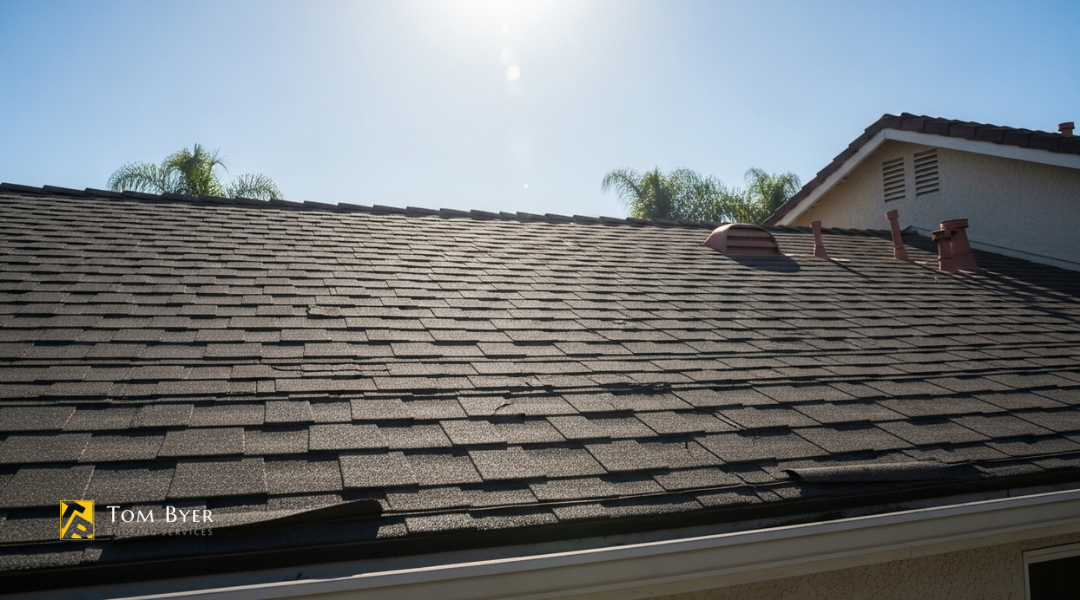
Thermal expansion happens as roofing materials repeatedly heat up and cool down. This constant change leads to the development of small cracks and warping. These issues weaken the roof’s integrity and can allow water infiltration if not addressed promptly.
Regular inspections can identify signs of UV damage and thermal stress early. Applying protective coatings or replacing compromised materials can extend roof life in this harsh sun exposure.
Occasional Storms And Debris Accumulation
Though Garden Grove’s climate is mostly dry, it occasionally experiences storms that bring rain and wind. These storms can dislodge shingles, loosen flashing, or create minor leaks in the roof.
Storms also cause trees to drop branches and leaves, which accumulate on roofs and clog gutters. This debris traps moisture, leading to mold growth, wood rot, and structural damage.
Homeowners should clear debris regularly and inspect the roof after storms. Prompt removal and repairs reduce the risk of prolonged water damage and maintain proper drainage.
Coastal Influence And Moisture Risks
Proximity to the coast means Garden Grove roofs face higher humidity and salty air. Salt exposure accelerates corrosion on metal components like flashing, gutters, and fasteners.
Moisture from ocean air increases the likelihood of mold, mildew, and moss growth on shaded or poorly ventilated roof areas. Excess moisture also speeds up material deterioration and affects the roof’s waterproofing layers.
Maintenance in this environment should focus on corrosion-resistant materials and ensuring good ventilation. Frequent inspections can detect moisture-related issues before they cause extensive damage.
DIY Roof Checks Vs. Professional Inspections
Routine roof assessments can help catch visible damage early and maintain roof health. However, some issues require specialized tools and expertise to identify. Knowing what to look for and when to seek professional help keeps a roof in good condition and avoids costly repairs.
What Homeowners Can Safely Look For
Homeowners can inspect their roofs from the ground or a safe vantage point. They should look for missing, cracked, or curling shingles, as these are common signs of wear.
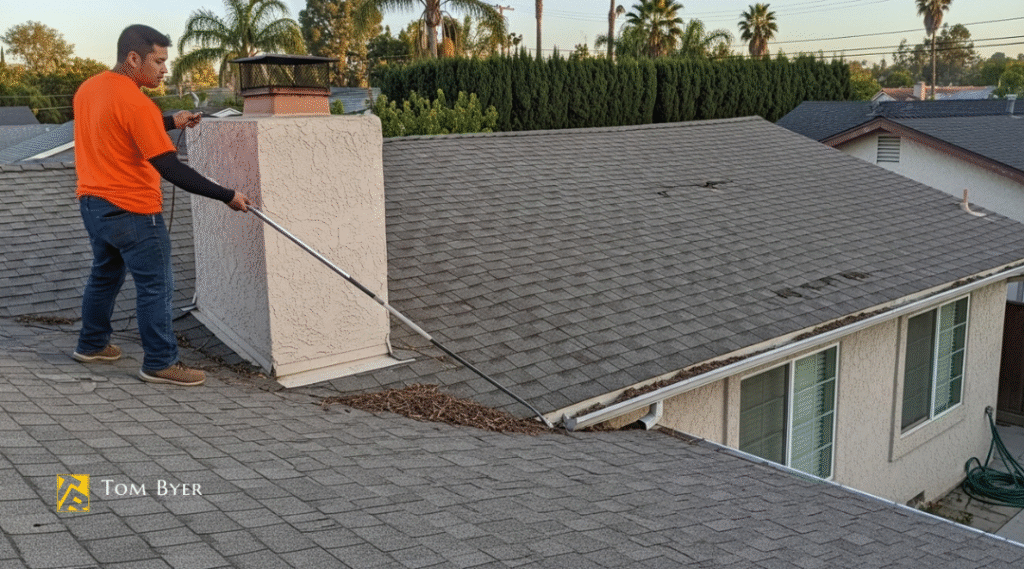
Checking for debris buildup in gutters and signs of water stains on ceilings or walls inside the home can also indicate roof problems. Additionally, spotting any visible sagging or damage to flashing around chimneys or vents is important.
Using binoculars or a drone can improve visibility without climbing on the roof. However, homeowners should avoid walking on steep or fragile roofs to prevent injury or further damage.
When To Call A Roofing Professional
A roofing professional is necessary for a detailed inspection, especially after severe weather events such as storms or high winds. If leaks, significant shingle damage, or structural concerns are suspected, a pro can diagnose and recommend repairs.
Professionals use tools like infrared cameras and moisture meters to identify hidden issues like trapped moisture or deteriorating underlayment. They can also safely access all roof areas, including those difficult to reach.
Routine professional inspections are recommended at least once a year to extend roof lifespan and maintain warranties. For Garden Grove residents, Tom Byer Roofing Service offers expert inspections tailored to local climate challenges.
Why Choose Tom Byer Roofing Service For Roof Inspections
Tom Byer Roofing Service offers thorough and reliable roof inspections that address local conditions, roof materials, and specific structural needs. Their approach ensures potential issues are identified early, with clear guidance on necessary steps.
Local Knowledge Of Garden Grove Homes And Buildings
Tom Byer Roofing Service has over 60 years of experience working with homes and commercial buildings in Garden Grove and the surrounding Southern California area. They understand local weather patterns, such as seasonal rains and intense sun exposure, that affect roofing materials.
This knowledge allows them to spot vulnerabilities unique to Garden Grove roofs, from tile shifts to wear on asphalt shingles. Their familiarity with local building codes ensures inspections meet regional compliance standards, avoiding potential permit or insurance problems. The company’s long-standing presence in the community means they are aware of common roofing materials used in the area and how they hold up over time.
Comprehensive Roof Inspection Process
The inspection process by Tom Byer Roofing Service is detailed and methodical. They start with a visual examination from ground level and accesses the roof to inspect shingles, tiles, flashing, gutters, and other components.
They look for signs of damage, moisture intrusion, and structural concerns. Specialized tools may be used to detect hidden leaks or weak spots. A full report with photographs accompanies each inspection, documenting findings in a clear and organized way.
This thorough evaluation helps property owners make informed decisions about maintenance or necessary repairs before problems escalate, potentially saving money on costly fixes later.
Honest Reporting And Repair Recommendations
Transparency is a priority for Tom Byer Roofing Service. After the inspection, customers receive an honest assessment of their roof’s condition without unnecessary upselling.
If repairs are recommended, the company provides detailed explanations of what is needed and why. Options are often presented so homeowners can choose solutions that fit their budget and roofing goals.
They emphasize trust and clear communication, helping clients understand the risks of delaying repairs and the benefits of timely maintenance to extend roof lifespan. This straightforward approach fosters confidence in their roofing expertise.

